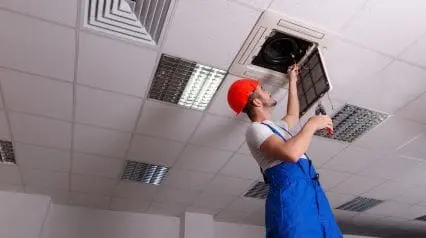What is Indoor Air Quality?
Indoor air quality (IAQ) refers to the air within buildings, establishments, vehicles, and other enclosed spaces. It is an important factor to consider when evaluating people’s health, especially in the workplace. When left unchecked or unmanaged, it can cause adverse effects on the occupants of a building or the environment.
Why is Air Quality Management in the Workplace Important?
Many hazards in the air are unseen, but are just as harmful as visible risks, if not worse. These hazards can come from people, equipment, crops, coal or oil-powered machinery, and certain work tasks, leading to harmful particulate matter in the air that can harm both humans and the environment
This is why monitoring and managing indoor air quality is essential. Its main purpose is to ensure workers are safe in the workplace. With most people spending 80% to 90% of their days indoors, staying aware of what is in the air is more important than ever. Keeping track of indoor air quality is also an important part of environmental justice, which the US Environmental Protection Agency (EPA) defines as the fair treatment and involvement of all people regardless of status, race, and income in the development, creation, implementation, and enforcement of environment-related laws and policies.
Another reason why indoor air quality management is essential is to improve work efficiency. Depending on the establishment’s structure, certain indoor pollutants can reduce the integrity or effectiveness of certain functionalities, particularly ventilation systems. At the same time, unhealthy indoor air quality can also create a chain reaction.
Factors that Affect Indoor Air Quality

Many things affect indoor air quality, as each building and environment has different factors to consider. However, according to the European Union Public Health Commission, some of the most common causes of polluted or lowered indoor air quality across all industries are:
- Chemicals, particularly those that emit strong or harsh scents
- Radon gasses
- Particles, both natural and man-made
- Microbes such as fungi and viruses
- Pets, pests, and their excretions
- Humidity levels
- Ventilation
- Temperature changes
Certain human tasks also contribute to poor indoor air quality. Some of the most common ones are smoking, tasks that involve generating dust and other particles, and activities that have strong scents involved in the process.
Outdoor air quality can also affect indoor air quality. Outdoor pollutants can enter through doors, windows, ventilation systems, and even cracks in a building’s structure. In some cases, they can also enter through the material of the building itself, should they be porous enough.
What are the Main Risks of Poor Indoor Air Quality?
The most common risk associated with poor indoor air quality is sickness and poor health. Respiratory illnesses such as coughs take up the top spots of health effects associated with indoor air quality, along with irritants to the skin, eyes, and nose. These can all lead to worse conditions, such as cancers or chronic illnesses.
Headaches are also likely to occur with constant exposure to hazards in the air, or when irritation or respiratory issues do not improve. When suffering from physical illnesses, injuries become more likely to happen as well.
Indoor air quality not only affects worker safety, but also productivity. With their health affected, workers will then be discouraged or unable to go to work. Absenteeism rates can increase, which can also affect a company as a whole. The same can also be said for retail establishments, as both employees and customers may opt to not visit them anymore for their health.
Poor indoor quality can also affect ventilation and heating. If the existing air contains particulate matter that’s harmful to Heating, Ventilation, and Air Conditioning (HVAC) units, it can cause breakages or lower performance.
How Can You Improve Indoor Air Quality?
There are multiple ways to improve indoor air quality. The first and most essential step is to remove any irritants and hazards from the air and their causes. For example, if a certain equipment or task is generating pollutants, it would be best to remove them from your processes or discover a new way to continue using or doing them safely.
Other ways to improve indoor air quality include the following:
- Comply with indoor air quality standards set by management and legal bodies
- Examine ventilation systems and perform regular maintenance on them
- Use products that are more environmentally friendly and do not release as little air pollutants as possible
- Open windows regularly to have fresh air come in
- Maintain outdoor air quality and ensure it is also within an acceptable air quality standard
In addition to taking proactive steps to manage and improve air quality, it is also important to install and use an indoor air quality monitoring system in your establishment to help you out. Multiple studies have shown that having a dedicated sensor for indoor air quality monitoring and quantifying it has helped prevent pollutants from increasing, which, in turn, has lowered the rate of sicknesses and injuries in the workplace.
Explore SafetyCulture Monitoring Solution
Utilize advanced sensor technology to monitor assets, automate vital alerts, implement actions, and report urgent issues.
Talk to an expert
By catching changes in indoor air quality as they happen, it can be easier to create strategic plans that can help air quality and improve workplace safety. It can also help manage outdoor air quality in the process, giving you a sense of what needs to be changed based on what happens inside the building.
FAQs about Indoor Air Quality
While good indoor air quality is a need for all, some industries have to be more mindful of theirs than others. This is because some industries have people constantly exposed to harmful particulate matter, which makes workers more at risk for illnesses and injuries.
Some industries that regularly deal with air pollutants include the following:
- Laboratory and health
- Construction
- Manufacturing
- Agriculture
According to the US Occupational Safety and Health Administration (OSHA), you can tell an establishment has a good indoor quality level or status if it meets the following criteria:
- People are comfortable with the temperature and humidity
- Air is flowing freely
- Pollutants are controlled both inside and outside the building
Proper ventilation improves indoor air quality and reduces the chances of respiratory illnesses, and this can be achieved by having a good ventilation system and letting fresh air in regularly. It is recommended to have fresh air in your workplace for at least a few minutes a day.
A good indoor air quality sensor will have the following features:
- A clear way to quantify the quality of indoor air
- Real-time readings
- Alerts to notify you and your staff of big or unsafe changes
- Mobile connectivity to easily access data
- Easy to use and set up



